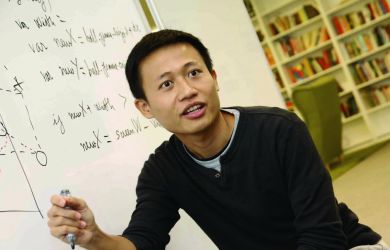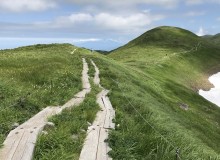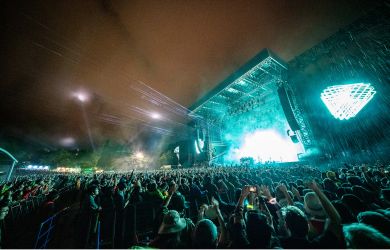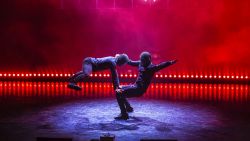
October 22, 2009
Open Reel Ensemble
With wit and a USB switch, Ei Wada conjures new music from an outmoded technology
Originally published on metropolis.co.jp on October 2009
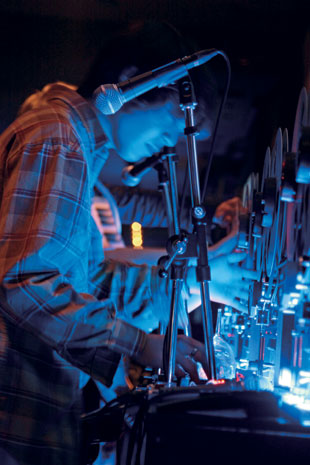
Courtesy of Open Reel Ensemble
Japan often looks back in nostalgia at resourceful inventors like Sony founder Akio Morita, who powered the nation’s postwar recovery with astonishing gadgets. Where are such forward-thinking talents today? Sitting down with Open Reel Ensemble’s Ei Wada at a Shibuya cafe, I sense I may be looking at the answer.
I first came across Open Reel at last spring’s 101Tokyo contemporary art festival. Against a backdrop of synchronized lights, Wada conducted what can best be described as a scratch symphony of hulking old reel-to-reel tape decks, which he had rewired with USB switches to trigger samples that he records live with his voice and an array of musical instruments. Using four decks in much the same way that a scratch DJ uses turntables, Wada and his three assistants were in constant motion as they created deft, visually arresting compositions that blend techno with hip-hop and jazz—all of it infused with a heady, art-student esthetic.
“When I was in grade school, I would record my voice on a cassette deck,” the elfin Wada recalls about the genesis of Open Reel. “I’d heard from my dad that open reel decks were even bigger, and eventually got my hands on one. I would record myself and play with it. I noticed that when you changed the speed, the tone would rise. But then I knocked it over, and broke it. It stopped turning, and began to make horrible sounds. I tried turning it with my hand, and a sound came out, “eeee,” and I was like, cool! So I began to experiment with strange sounds, recording while turning the reel.”
Around the time Wada entered Tama Art University, he became aware of the iPhone and other inexpensive devices, and an idea began to germinate. He was a big fan of digital music, but was disappointed with the way the physical performance aspect was being lost as music technology became easier to manipulate.
“I thought it might be possible to put together a reel-to-reel deck with a computer controller, and then use it as a composition instrument, in which the motion would be part of the piece, and part of the performance,” he says. “The most interesting part for me was the connection between the sound and the motion—they absolutely had to be together.”
Wada had soon acquired a bunch of used decks off internet auctions. “What’s interesting about the older technology is exactly that it’s inconvenient—that you have to practice to get better,” he says. “Like a real instrument, you get better as you practice, instead of simply pushing a button. Rather than instant gratification, you have to apply yourself.”
Why four decks? “I wanted to use four from the beginning, to make it like a band, with a bass, drum, melody and harmony, a bit like Kraftwerk,” he explains. “I bought them through an online auction, fixed them up, and then attached new technologies. It began as a university project, and I got friends together to help.”
It took Wada a few years and a lot of diagrams and experimentation to get his rewired decks to the point where they could be easily manipulated as real-time “samplers,” but by last year he had debuted the Open Reel Ensemble to immediate acclaim. The four-piece group soon found itself invited to perform at venues from art galleries to nightclubs. Testifying to the diversity of its appeal, Open Reel was featured at August’s Summer Sonic rock festival and currently has an installation at NTT’s high-concept InterCommunication Center multimedia museum in Shinjuku.
The group’s sound-and-motion ballet can be appreciated on a visceral level, but there is also a deeper, retro-futurist thinking behind Wada’s approach that he terms chigatta ima (alternative present).
“When I studied sociology, we had to envision different scenarios—this intrigued me,” he says. “For example, if clocks moved backward, or computer keyboards were arranged differently, there might be an ‘alternative present.’ The decks are now sold as junk on the net, but if you attach a USB controller, you bring together digital and analog in a way that gives new life to an outmoded technology.”
As with the young Akio Morita, Wada seems to have only just embarked on a life of invention.
“I want to work with many different people, and also have a lot of ideas for new technology,” says the 22-year-old, who is still in school. “For example, I want to make a ‘sampling table’ that would allow you to sample with magnetic tape stretched across a table—it would be a new kind of instrument. But everything I do should have a strong performance element.”
Open Reel Ensemble
Experimental analog performance unit. Nov 6, 10pm, ¥2,000. Club Wire, Shinjuku. Tel: 03-3207-6953.
NTT Intercommunication Center
Emergencies! 012: Wada Ei, Composition in Motion. Various media. Until Nov 15, free. 4F Tokyo Opera City Tower, 3-20-2 Nishi-Shinjuku, Shinjuku-ku. Tel: 0120-144199. Open Tue-Sun 10am-6pm, closed Mon. Nearest stn: Hatsudai. www.ntticc.or.jp
